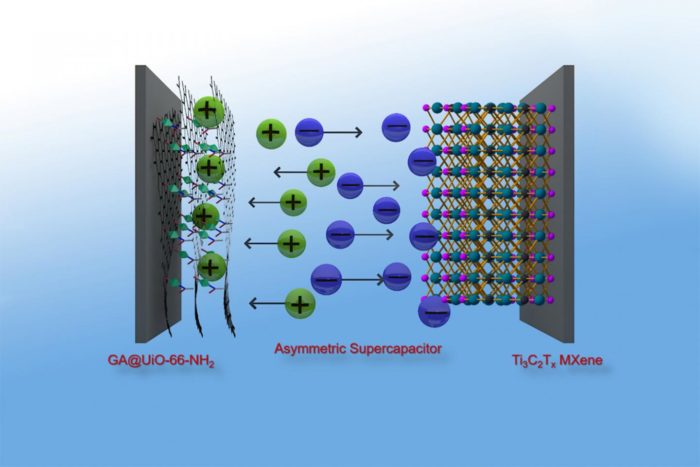Jan 08 2021
Graphene Supercapacitors
 While trying to imagine the future of our energy infrastructure we should not forget to include the possible role of capacitors as a means of storing energy. Energy storage is critical for electronic devices, electric vehicles, grid storage, and more. Right now batteries tend to get the most attention, but we should not neglect capacitors.
While trying to imagine the future of our energy infrastructure we should not forget to include the possible role of capacitors as a means of storing energy. Energy storage is critical for electronic devices, electric vehicles, grid storage, and more. Right now batteries tend to get the most attention, but we should not neglect capacitors.
A capacitor, in its simplest form, contains two conducting plates separating by a thin insulting layer. Energy is stored in an electrostatic field between the two plates. (Read here if you want more details.) Capacitors have some useful advantages over batteries. They can store and discharge energy much more quickly than batteries. This makes them superior for applications that require a burst of energy (in either direction). Capturing the energy of a breaking train, for example, would be an ideal application for a capacitor.
Capacitors also have a higher power density than even the best batteries. Power density is the amount of power that can be produced by a certain mass of the object. A capacitor can provide 10 kW of power in a lighter package than even a lithium ion battery. However, capacitors have a much lower energy density (measured in kWh/kg) than the best batteries. Batteries therefore last longer for their weight – by about a factor of 20. The battery pack of a Tesla Model 3, for example, weighs 1,200 pounds (540kg). A capacitor with the same range would weigh 24,000 pounds. This is obviously a deal-killer.
Capacitors have other advantages, however. They have a much longer lifespan, because they do not rely on chemicals which can break down or crystalize. Capacitors can last millions of cycles. They also don’t overcharge and don’t overheat, so we don’t have to worry about them catching fire or exploding.
Therefore supercapacitors would be vastly superior to batteries for cars and many other applications, if it weren’t for that pesky energy density. Now they are used for niche applications where power density and rapid charging/discharging are critical. They are also used in tandem with batteries. For example, an electric car can have a capacitor to use for regenerative braking, but a battery for range.
Researchers, predictably, are on the hunt for materials that can increase the energy density of supercapacitors. One promising candidate is some form of graphene, that magical two-dimension allotrope of carbon. A recent study reports:
The team working with TUM chemist Roland Fischer has now developed a novel, powerful as well as sustainable graphene hybrid material for supercapacitors. It serves as the positive electrode in the energy storage device. The researchers are combining it with a proven negative electrode based on titan and carbon.
The new energy storage device does not only attain an energy density of up to 73 Wh/kg, which is roughly equivalent to the energy density of an nickel metal hydride battery, but also performs much better than most other supercapacitors at a power density of 16 kW/kg. The secret of the new supercapacitor is the combination of different materials – hence, chemists refer to the supercapacitor as “asymmetrical.”
For context lithium ion batteries have energy densities from 100-265 Wh/kg. So the best Lithium ion battery has 3.6 times the energy density of these graphene-based supercapacitors – that is a lot better than 20. There are still always the non-trivial questions of whether or not this new material can be cost effective and mass produced. But at least supercapacitors in the lab are getting into the battery range of energy density.
The question then becomes – at what point are the many other advantages of supercapcitors worth the trade-off of lower energy density? Assuming equivalent manufacturing costs (I know this is a big assumption) when supercapacitors equal batteries in energy density, they will be a no-brainer to replace them (unless I’m missing something). But even if batteries have a modest advantage in energy density, supercapacitors may still be the better choice for some applications.
Supercapacitors may have another practical advantage – it may be easier to build them into structural material. Let’s imagine that Tesla Model 3 again – they weigh about 4,000 lbs, 1,200 of which is battery. Let’ say a supercapacitor with the same range weighs twice as much, 2,400 lbs. But half of that can replace structural material in the car itself, so the overall weight of the car remains the same. I don’t know how practical this is, but this is an idea engineers are working on. Perhaps this would be better suited to something like a wind turbine, where the supporting tower is also mostly a supercapacitor that stores the energy generated from the turbine, providing built-in grid storage.
Battery tech is advancing at the same time, of course, so the two technologies are in a race. Battery technology is steadily and incrementally improving not only energy density but life-span and stability, while supercapacitors are increasing their energy density. It seems likely we will have both for a long time, perhaps indefinitely, with different combinations for different applications. But having a supercapacitor with a high enough energy density to compete directly with batteries in applications traditionally only suited for the latter would be an interesting development.






